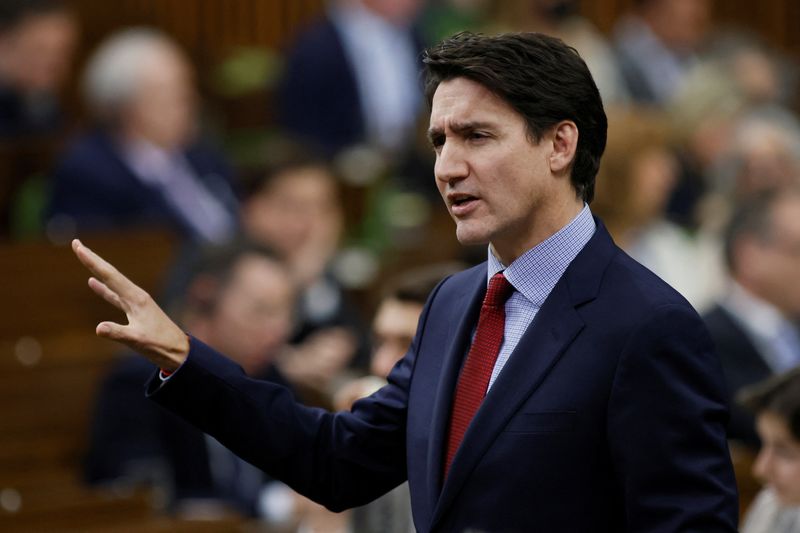By Promit Mukherjee
OTTAWA (Reuters) – Canada’s fiscal targets over the next few years will be tougher to achieve as a promised Christmas handout last month by Prime Minister Justin Trudeau amplifies the impact of falling growth from immigration curbs.
Combined with other pressures such as a commitment to increase defense spending, the United States threatening export tariffs, and additional spending temptations in an election year, Canada’s debt and deficit projections are precarious, economists and academics said.
Fiscal deficit and government debt are not a top priority for Canadian voters, who are more worried about affording housing or groceries. Cost of living and a housing shortage have shrunk Trudeau’s approval ratings ahead of an election that must be held within a year.
However, in the long run, the fiscal metrics impact the government’s ability to provide for social programs and force higher taxes on the population.
On Nov. 21, Trudeau promised to send a C$250 ($178.81) cheque to nine out of every 10 working Canadians. He also announced a sales tax freeze on essential goods from Dec. 14 to Feb. 15.
“It’s good politics and bad policy,” Mahmood Nanji, Lawrence Centre Policy Fellow at Ivey Business School, said of the latest measures.
There is no clarity on whether the government will raise new debt or shift spending from somewhere else to fund the initiatives, Mahmood said. The tax breaks passed parliament, while the cheques have not yet been presented.
Public spending in Canada ballooned during the COVID-19 pandemic, with the gap between the government’s revenues and expenditures in 2020 widening to its highest level since World War Two. Trudeau has since publicly committed to fiscal responsibility.
Finance Minister Chrystia Freeland, after postponing the government’s debt reduction goals twice in 2023, promised a 2023-24 deficit at or below C$40.1 billion, to reduce the debt-to-GDP ratio, and to keep the deficit-to-GDP ratio below 1% by 2026-27 and beyond.
The government has not yet released its 2023/24 fiscal year’s final spending and revenue numbers. Randall Bartlett, senior director of Canadian economics at Desjardins, believes that the annual fiscal deficit target has been missed.
“I suspect the federal government has made the decision to set its fiscal anchors aside,” Bartlett said.
Asked about the targets on Tuesday, Freeland said a mid-term budget called the Fall Economic Statement will have details of spending and fiscal anchors.
The statement is later than usual due to gridlock in parliamentary proceedings, she said, but added that Canada’s fiscal position was strong and it has the lowest debt and deficit amongst the G7 countries.
SPENDING ABOVE TARGET
For the first six months of the year, total government spending has increased by over 11%, already above the full-year target of 7%.
Canada’s economy is growing as interest rates come down, although below the Bank of Canada’s forecast. GDP has shrank on a per-person basis for six consecutive quarters.
An aggressive push to cut immigration numbers could further slow growth, inflating the debt and deficit, economists said.
With polls showing Canadian support for new immigrants declining due in part to worries about enough housing, Trudeau announced measures in October to curb immigration that will result in a population decline of 0.2% in both 2025 and 2026.
Cynthia Leach, assistant chief economist at Royal Bank of Canada, said the drop in population could shave off 2.7% in total relative to prior GDP projections by the end of 2027, which translates into C$25 billion less in government revenues.
“The government is running awfully close to its fiscal anchors,” she said.
Freeland said the pause in immigration is healthy for the economy.
Canada, the world’s tenth-largest economy, enjoys AAA credit ratings from two of three rating agencies.
Fitch rates the country one notch lower, and sees some risk, director Joshua Grundleger said.
“Risks are clearly to the downside, both from economic weakness and the fiscal weakness. But I don’t see a blowout here that would lead to immediate rating actions in the short run,” he said.
Under pressure from NATO allies and the United States, Canada has committed to increasing defense spending to 2% by 2032 from 1.4% last year. And U.S. President-elect Donald Trump launched a new threat to Canada’s economy last month, saying he would put a tariff of 25% on all goods. Canada sends 75% of its exports to the United States.
Avery Shenfeld, managing director and chief economist at CIBC (TSX:CM), said it was too early to conclude that the government was abandoning its fiscal targets this year, since its operating budget is large enough to find savings.
However, Trump’s tariffs or additional stimulus measures could lead the government to cast aside its targets, he said.
“It’s possible that they will be tempted to do so in what is poised to be an election year in 2025.”
($1 = 1.3981 Canadian dollars)

